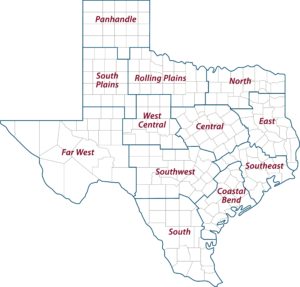Adequate chill hours and good spring conditions have peach and other fruit producers excited about 2018, according to a Texas A&M AgriLife Extension Service specialist. Dr. Larry Stein, AgriLife Extension horticulturist, Uvalde, said production levels should increase for most fruit producers around the state following near-perfect winter and early spring conditions.
Much of the state received ample damp, cloudy days with temperatures between 32-45 degrees, which are ideal for accruing chill hours, Stein said.
Chill hours begin to add up after the first freeze each fall, he said. Trees go dormant for the winter, but chill hours promote hormones that dilute growth inhibitors throughout the winter and prepare the plant to break dormancy and promote growth, bloom and set fruit.
“Trees bloomed extremely well and to my knowledge everyone has a crop that looks good to really good,” he said. “Chill hours are the No. 1 factor, and moisture was good coming into fall and winter, so trees should be in good shape for fruit production.”
Thinning fruit should be a priority for producers who want good fruit size, because high volume fruit sets are expected, Stein said.
“That takes time and labor,” he said. “Heavy sets may need thinning two or three times.”
Heavier labor requirements will be welcome after two seasons with warm winters and poor chill hour accrual, Stein said. The lack of chill hours weakens trees and in extreme cases can cause poor leafing, which can render trees too weak to produce, or kill them.
“Trees that aren’t managed appropriately may have been at risk of being too weak to produce good sets, but I haven’t heard of any major cases of that occurring among established growers,” he said. “I’ve heard of cases of individual yard trees dying, but not in production orchards.”
Stein said there is still a possibility of a late freeze for some areas, but he is doubtful it would be significant enough to damage fruit sets. A minor freeze could help producers thin fruit from their trees.
“The thing that would worry me still is spring thunderstorms that produce hail,” he said. “There has been some wind and hail damage in the Hill Country and southeast of that region. It’s a concern, but there is not much you can do about Mother Nature.”
Moisture levels were a concern before a recent good general rain provided good soil moisture across much of the state’s major production areas, he said.
Stein said producers will also need to stay on top of typical disease and pest management.
“If it keeps raining, they’ll want to stay on top of their spray program,” he said. “Overall, and I always hate to get ahead of myself, it looks like everyone should expect production levels to be up from last year.”
AgriLife Extension district reporters compiled the following summaries:

CENTRAL: Counties received much-needed moisture. Lots of field work was being done. Wheat was healthy and in the boot stage without disease presence. Corn and grain sorghum were off to a good start. Pasture conditions were improving. Warm-season forages that were fertilized were growing very well and emerging from dormancy. Pecan trees were budding. Livestock were in fair condition, and supplemental feeding was slowing down. Tanks were full. Nearly all counties reported good soil moisture. Nearly all counties reported good overall livestock, crop, rangeland and pasture conditions.
ROLLING PLAINS: Rain fell across parts of the district with amounts varying from 0.5-5 inches. Dormant range and grasslands were sprucing up after the rain, and growth potential was great. The rain significantly extended wheat pasture grazing and got pasture green-up off to a great start. Early planting of sorghum and a few acres of corn were expected to start as soon as the ground dries out. In the drier counties, livestock were in fair condition and producers were still providing supplement feed and hay, but grasses were growing. Winter wheat did not look good for grain production in the western counties with several fields expected to be eligible for crop insurance due to low production. Soil moisture was still a critical issue in some areas, but another rain should set farmers up to plant cotton.
COASTAL BEND: Much-needed rain fell with amounts ranging from 1.75-3.5 inches. Most cotton planting began, although some planting was delayed due to limited moisture. The forecast called for additional rain showers. Corn and grain sorghum planting was close to completion, and rice planting was underway. Fertilizer and herbicide applications continued in hay fields and pastures. Cattle were looking better, and calves were doing great.
EAST: Rainfall throughout the district left fields and pastures saturated with reports ranging from 2 inches in Gregg County to 10 inches in Jasper County for the reporting period. Topsoil and subsoil conditions were both reported as adequate throughout the district. Seasonable soil temperatures allowed forage grasses to continue steady growth. Pasture and rangeland conditions were reported as fair to good. Gregg County reported producers continued to fertilize pastures, and Marion County producers tilled and planted gardens. Weekend farmers markets opened in Gregg County. Producers reported livestock were in good condition with very little supplementation taking place. Cattle gained weight and calves were growing well. Local sale barns in Gregg County reported cattle prices were up, while prices in Shelby County were down, though both reported fair numbers. Wild pig damage was reported by Henderson and Upshur counties. Henderson County also reported growing fly numbers. Gregg County producers continued applications of herbicides for warm-season weeds.
SOUTH PLAINS: Subsoil and topsoil moisture levels remained very dry. Most counties received rainfall ranging from 0.5-2 inches. Rainfall allowed growers to prepare fields with tillage and incorporate some pre-emergent fertilizer. Winter wheat and pastures were in poor to fair condition and needed moisture.
PANHANDLE: The district remained extremely dry. Scattered showers left a trace to a third of an inch of rain in some areas. Wheat conditions continued to decline without any significant moisture. Irrigated wheat producers were watering. Producers were waiting on rainfall before planting, and some were still trying to determine what they should plant. Cotton acres were expected to increase again this year. Some prewatering for corn began in the northwest corner of the region in preparation for planting after mid-April. Most wheat pasture cattle were shipped. Showers during the last reporting period helped rangeland conditions, but without consistent rain any green up will be short-lived. Cattle were being supplemented on range. Fire dangers remained high for rangelands.
NORTH: Topsoil and subsoil moisture levels were mostly adequate across the counties. More rain was received with reports of 2.5 inches across most counties. Temperatures were cooler with cloudy conditions. Rains temporarily stopped corn planting. About 40-50 percent of corn was planted. Some corn was up and some was beginning to emerge. As soon as field conditions dry some, cotton farmers should start planting. Wheat, oats and winter annual pastures looked much better after the heavy rains a few reporting periods ago. Most farmers fertilized pastures and put down weed control before rains this reporting period. There were signs of warm-season grasses coming on, so it shouldn’t be long before good growth. Cattle slowed down on hay consumption and were seeking green grass. Livestock were doing well, but up and down temperatures were causing some stress.
FAR WEST: Temperatures saw highs in the 90s and lows in the 50s. Average rainfall reports were 0.8 of an inch or less. Trace rainfall dried out from high temperatures and gusty winds. Fire dangers remained high. Corn planting began, but acreage was expected to be down due to increased need for prewater. Cotton preplant irrigation was ongoing. Pecan trees and alfalfa fields were irrigated as well. Pima and extra long staple cotton planting was expected to begin within the next two weeks. Pastures contained almost no grass. Some pastures were greening up in bottoms due to spring conditions. Mesquite trees were breaking buds and greening up sporadically. Lambing and kidding was still going on.
WEST CENTRAL: Most areas received 1-2 inches of rain, but more was needed. Stock tanks needed runoff water to fill before summer. Recent scattered showers provided some moisture, but subsoil moisture remained very dry. Throughout the district, rainfall allowed wheat to reach completion; however, the crop was still behind. Green-up was occurring and grazing was improving. Due to the recent rainfall, supplemental feeding of livestock reduced. Cool-season forages were growing. Some small mesquite trees put out leaves and some pecan bud-break occurred. The rain should help grain sorghum and corn. Field preparations for cotton were ongoing. Cotton producers continued to apply herbicides for spring weeds and bed cotton ground. Livestock remained in mostly fair condition and prices held steady at local cattle markets.
SOUTHEAST: Heavy rains brought 2-9 inches of rain to several counties. Most counties were very wet and ditches were still full of water. Many gardens sustained large amounts of damage due to high winds and excess water from the past two storms. The northern part of Lee County received small hail. A cool front came in with storms bringing temperatures into the 80s and mid-50s. Some vegetable producers were forced to replant while others were waiting for soil to dry enough to replant. Pasture forages looked good. Waller County received 2 or more inches this week. Overall pasture and crops appeared to be progressing well going into spring. Livestock appeared to be in the best condition so far this year. Rangeland and pasture ratings varied widely, from excellent to very poor with good ratings being most common. Soil moisture levels ranged widely from adequate to surplus with surplus being most common.
SOUTHWEST: Recent rainfall improved rangeland and pasture conditions throughout the district. New growth on trees and grasses emerged overnight, as did wildflowers. Livestock conditions were good.
SOUTH: Conditions were mild with rainfall amounts ranged from 0.25 inch to 4 inches for much of the district. Soil moisture levels improved in areas that received rain. The southern areas of the district remained hot and mostly dry with scattered showers, but soil moisture remained short. Rust presence increased on wheat and oat fields. Pasture and rangeland conditions continued to improve, but were poor in some areas. There were weed problems in pastures in some areas. Supplemental feeding declined some, and body condition scores on cattle remained fair. Watermelons, cantaloupes and onions were planted. Carrots and onions were doing well. Coastal Bermudagrass fields were almost ready for the first hay cutting. Spinach harvest was winding down. Corn, sorghum and cotton were doing well. Wheat and oats were maturing nicely. Pecan trees were starting to bud and develop foliage. Some producers began to move cattle to other pastures as stock tanks began to dry up. Supplemental feeding of range cubes and hay continued. The live cattle price market continued to fall. In Hidalgo County, harvest of sugarcane, citrus and vegetables continued. Some onions were being harvested and sesame was being planted.
Source: AgriLife Today
